Electronics is a branch of physics and engineering that involves controlling the flow of electric charges in certain devices for a useful purpose. Electronic components (parts) are used in a broad range of products, including computers, cell phones, radios, televisions, video game consoles, and medical instruments.
Electronics is based on our understanding of electricity. Electricity includes two important elements: (1) electric current and (2) electric voltage. Electric current is the flow of electric charges. Electric voltage is a type of “pressure” or force that causes the charges to move in the same direction. Familiar uses of electricity include the furnishing of energy in homes and businesses to provide light and heat, and to drive motors.
Electronics deals chiefly with the use of current and voltage to carry electric signals. An electric signal is an electric current or voltage modified in some way to represent information. A signal may represent sound, pictures, numbers, letters, computer instructions, or other information. Signals can also be used to count objects, to measure time or temperature, or to detect chemicals or radioactive materials.
Electronics depends on certain highly specialized components, such as transistors and integrated circuits, that serve as parts of almost all electronic equipment. The value of such devices lies in their ability to manipulate signals extremely fast. Many components can respond to signals billions of times per second.
The field of microelectronics is concerned with the design and production of miniature components, chiefly integrated circuits, and of electronic equipment that uses such components. Manufacturers can create millions of microscopic electronic components on a piece of material—called a chip—no larger than a fingernail.
This article provides a broad overview of the basic tools and functions of electronics and the electronics industry. Separate World Book articles give detailed information on many of the topics. For a list of these articles, see the “Related articles” at the end of this article.
Uses of electronics
Electronics has changed the way people live. People have come to depend on electronic products in almost every part of their daily lives.

In communications.
Electronic communication systems link people throughout the world. People in different countries can communicate almost instantly using telephones or the Internet. A television viewer can watch events on another continent as they are taking place.
Loading the player...Cellular telephone
Processing information.
Electronic computers are used in business, education, government, industry, and science. People depend on computers to handle vast amounts of information with incredible speed and to solve complex mathematical problems in a fraction of a second. Online services provide computer users instant access to a wide variety of information and features through high-speed communications links and wireless networks. In the entertainment industry, electronic systems produce sophisticated special effects for motion pictures and complex graphics for computer and video games.
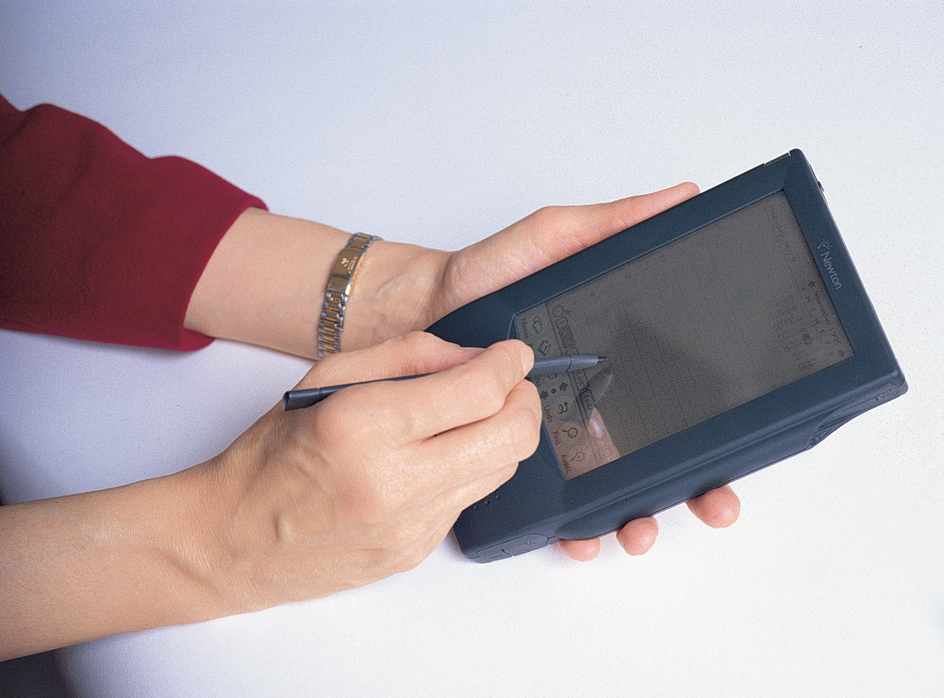
Medicine and research.
Physicians use a variety of electronic instruments and machines to diagnose and treat disorders. For example, X-ray machines use radiation produced in a special type of electronic vacuum tube to take pictures of bones and internal organs. Physicians analyze these pictures to detect injuries and diseases. Radiation therapy, or radiotherapy, uses X rays and other forms of radiation as a powerful weapon against cancer. Magnetic resonance imaging (MRI) machines use powerful magnets and complex electronic processing devices to produce three-dimensional representations of tissues inside the body.
Computers and other electronic instruments provide scientists and other researchers with a clearer understanding of nature. For example, computers help scientists design new drug molecules, track weather systems, and test theories that describe how galaxies develop. Electron microscopes can magnify specimens by 1 million times.
Automation.
Electronic controls improve the operation of many common home appliances, such as refrigerators, air conditioners, and washing machines. Microwave ovens heat food quickly by penetrating it with short radio waves produced by a vacuum tube.
Loading the player...Microwave oven
Industries use computers to control other machines. Electronic robots perform a wide variety of tasks that are boring, difficult, or dangerous for people. The high level of precision that electronic control systems provide makes it possible for manufacturers to produce integrated circuits and many other advanced products.
Air, sea, and space travel depend on navigation by radar, radio, and computers. The Global Positioning System (GPS) uses electronic systems in satellites and on the ground to calculate the precise geographic locations of devices called GPS receivers anywhere in the world. Most automobiles have electronic controls in their engines and fuel systems. Also, electronic devices control the inflation of air bags—safety devices that inflate to help protect a driver or a front-seat passenger in a collision.
How an electronic system works
To provide a basis for understanding electronics, this section describes how a common product, a handheld electronic calculator, works. A calculator has a small keypad with keys for numbers and operations, and a display screen that shows results. Most calculators are powered by a small battery or by a panel of solar cells.
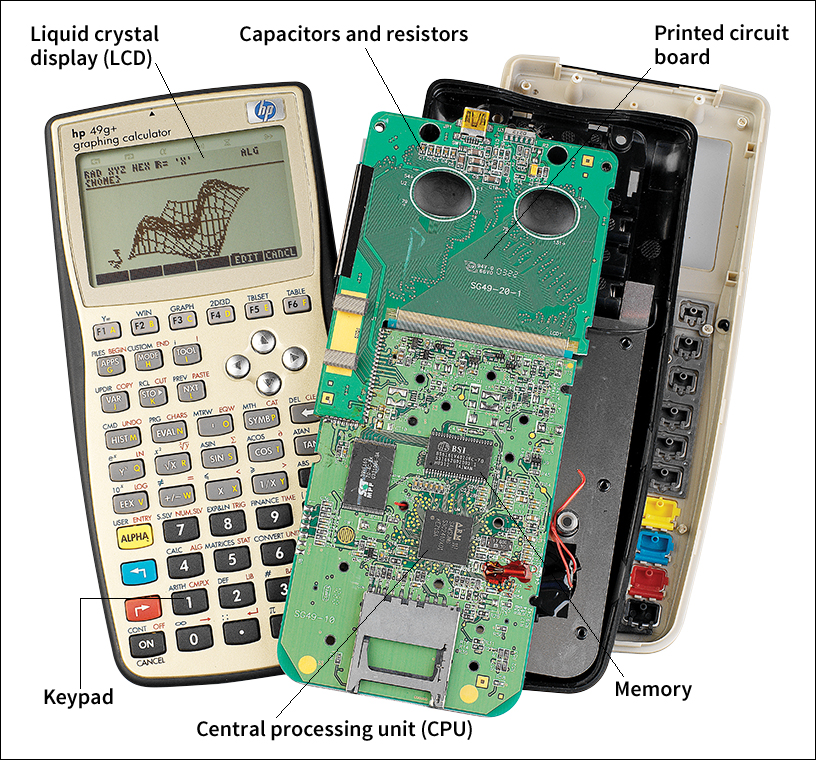
Beneath the keypad, tiny circuits operate the calculator. A circuit is a set of connected parts through which current flows. Pressing a key creates a pulse of electric charge representing a number or operation—in other words, a signal. The signals travel through wires to the circuits.
Each circuit has a job. Some circuits store signals temporarily, awaiting further instructions. Others change signals according to instructions. For example, a circuit might multiply two numbers together. Finally, circuits send signals that light up or darken certain areas on the display screen to show the result of a calculation.
The operations of a calculator, like most electronic systems, can be divided into three stages: (1) the input stage, in which information enters the system as signals; (2) the processing stage, in which the signals are manipulated in some way; and (3) the output stage, in which the processed signals are changed into a form that the user can understand. Systems use various types of input and output devices that produce or respond to signals. For example, radio and television broadcasting require such devices as microphones and loudspeakers. From the time signals leave the input device until they reach the output device, the signals can go through a number of changes. The electronic components working within circuits make these changes.
Electronic circuits
In any electronic device, a circuit provides a pathway for the electric current that operates the device. A calculator has a complex circuit. Many of the parts of this complex circuit are actually smaller subcircuits that perform particular jobs. Not all of the circuits necessarily work at the same time. Certain components act as electronic “switches,” turning circuits “on” and “off” as needed. When a switch allows current to pass through a circuit, the circuit is on. When a switch blocks current, the circuit is off.
How a circuit works.
To understand how an electronic circuit works, one must know something about atoms. Every atom has one or more electrons—particles that carry a negative electric charge. Atoms also contain protons—particles that carry a positive electric charge. Opposite charges attract each other. Like charges repel (push away from) each other. Circuit operation is based on the flow of electric charges.
The flow of electrons in one direction at a time forms an electric current. Voltage, also known as electromotive force, is the “pressure” or force that drives the electrons. In circuits, voltage is the electrical attraction caused by the difference in the charges between two points in the circuit. A power source provides voltage. Batteries are a common power source. One end of a battery supplies a negative voltage, and the other end supplies a positive voltage. Electronic systems that plug into an electric outlet receive power from a commercial power plant.
Electrons flow from the negative voltage end of a circuit to the positive voltage end. This movement of electrons creates an electric current. Scientists, however, traditionally describe the direction of an electric current as flowing from positive to negative. Until the late 1800’s, when the electron was discovered, scientists mistakenly believed that charges flowed from positive to negative.
Wires and certain other parts of circuits are made of materials called conductors, which can carry an electric current. In conductors, which include most metals, each atom has one or more electrons that can move from atom to atom. These electrons are called free electrons or charge carriers. Circuits also contain insulators, materials that block current because they have no free electrons.
As electrons move through a conductor, they collide with the atoms of the material. Each collision hinders the flow of electrons and causes them to lose some energy as heat. Opposition to electric current, which changes electric energy into heat, is known as resistance. A build-up of heat can damage a circuit. Some electronic devices, including some computers, generate so much heat that their circuits must be continually cooled by the flow of air or liquid.
Types of electronic circuits.
Manufacturers make two types of electronic circuits: (1) conventional and (2) integrated. A calculator, like most electronic devices, has both kinds.
Conventional circuits
consist of separate electronic components connected by conductors and fastened to a base. Manufacturers typically attach the components to a printed circuit board, a thin piece of plastic or other insulating material upon which copper conductors are printed by a chemical process at the time of manufacture. In a calculator, all the electronic parts of the main circuit are connected on a printed circuit board.

Integrated circuits
have components and connectors formed on and within a chip—a tiny piece of semiconductor material, usually silicon. A semiconductor is a substance that conducts electric current better than an insulator, but not as well as a conductor. The chip serves not only as the base but also as an essential part of the circuit. Integrated circuits often serve as components of conventional circuits.
To make an integrated circuit, engineers prepare a large master design of the circuit with the help of a computer. A photographic process reduces the master design to microscopic size. Chip manufacturers treat silicon to alter its conductive properties by adding small amounts of impurities called dopants, such as boron and phosphorus. The treated regions form the chip’s electronic components. One chip can contain millions of microscopic parts connected by thin “lines” of metal. Chip makers arrange the parts and connections in complex patterns in several layers. Finished circuits are mounted in casings that are connected to a printed circuit board.
The small size of an integrated circuit gives it several advantages over a conventional circuit. For example, an integrated circuit works faster because the signals have less distance to travel. Integrated circuits also use less power, generate less heat, and cost less to operate than conventional circuits. In addition, integrated circuits are more reliable because they have fewer connections that might fail. But because of the small size of their components, integrated circuits can be damaged by strong currents and high voltages.

A type of integrated circuit called a microprocessor performs the same types of mathematical and memory functions that a large computer does. Microprocessors control many products, including microwave ovens, video game systems, robots, and smartphones. A microprocessor serves as the “brain” of every personal computer. Larger computers often have several microprocessors that can work together at the same time.
Active components
Active components in electronics control, modify, amplify, and process electronic signals. From the early 1900’s to the 1950’s, vacuum tubes were an important part of most electronic equipment. Various metallic elements within an air-tight tube controlled the flow of electrons through a vacuum. Some equipment still uses special types of vacuum tubes. For example, microwave ovens use a tube called a magnetron to produce microwaves. Other types of vacuum tubes produce high-power radio and radar signals and X rays. For more information about the various kinds of vacuum tubes and how they work, see Vacuum tube.
Nearly all active components produced today are solid-state components. In transistors and other solid-state components, signals flow through a solid semiconductor material instead of through a vacuum. Solid-state devices use less power, last longer, and take up less space than vacuum tubes. Engineers developed the first successful transistor during the 1940’s. Since that time, semiconductors have replaced vacuum tubes for nearly all uses.
Most solid-state components are made of the semiconductor silicon. Silicon and similar semiconductors are useful because engineers can precisely adjust their resistance and thus control the flow of current through them. The behavior of semiconductors relates to the branch of physics called quantum mechanics. See Quantum mechanics.
To be used for most electronic devices, the atoms of a semiconductor must form a crystal structure—that is, a repeating pattern of atoms in all directions. In these crystals, the outer electrons of neighboring atoms are linked in pairs known as electron bonds or a covalent bonds. Ordinarily, the outer electrons are tightly bound to the atoms of the crystal, and the material acts as an insulator, resisting the flow of charges.
To enable charge to flow in the semiconductor, engineers add extremely small amounts of dopants to pure silicon crystals. The dopants increase the silicon’s ability to conduct current. There are two types of doped semiconductors: (1) p-type, which contain mostly positive charge carriers; and (2) n-type, which contain mostly negative charge carriers.
To create p-type semiconductors, engineers add dopants whose atoms have one fewer outer electron than a silicon atom has. Aluminum, boron, indium, and gallium are p-type dopants in silicon. Each dopant atom creates a hole—that is, the absence of an electron bond—in the crystal structure. A hole acts as a positive charge carrier, attracting electrons from neighboring atoms. These neighboring atoms are then left with holes. Thus, a hole can move from atom to atom.
To create n-type semiconductors, engineers add dopants whose atoms have one more outer electron than a silicon atom has. Arsenic, phosphorus, and antimony are n-type dopants in silicon. At room temperature, the extra electron is free to move within the crystal and acts as a negative charge carrier.
Manufacturers make various solid-state electronic devices by forming different combinations of p-type and n-type semiconductors within a continuous crystal. The place where the two types of semiconductors meet is called a p-n junction. The number and arrangement of p-n junctions, as well as the type and amount of dopants, determine how a device works.
Diodes
are electronic components that prevent current from flowing in one direction but not the other. A semiconductor diode consists of a p-n junction in which a piece of p-type semiconductor is in contact with a piece of n-type semiconductor. A diode has two terminals (metal pads for making electrical connections). The terminals connect the end of each type of semiconductor material to the circuit. A diode can be built into an integrated circuit, or can form a discrete (separate) component of a conventional circuit. A discrete diode is enclosed in a protective casing.

How a diode works.
A diode is basically a switching device that allows current to flow in only one direction. The current is carried by the flow of holes and electrons. The bias (direction) of the applied voltage determines if the p-n junction blocks current or allows it to flow.
A forward bias allows current to flow through the junction. To create a forward bias, a battery or other voltage source applies a negative voltage to the n-type material and a positive voltage to the p-type material through the terminals. In simple terms, the negative voltage repels the free electrons in the n-type material toward the p-n junction. Likewise, the positive voltage repels the holes in the p-type material toward the junction. The electrons move across the junction into the p-type semiconductor. For each electron that crosses into the p-type material, the voltage source pumps one electron into the n-type material from the terminal and pulls one electron out of the p-type material through the terminal. As a result, electrons flow through the circuit. A small increase in the strength of the voltage causes a large increase in the current flowing through the diode. When the voltage is removed, electron flow stops.
A reverse bias prevents most current from flowing through the p-n junction, though a small leakage current gets through. To create a reverse bias, a voltage source applies a negative voltage to the p-type semiconductor and a positive voltage to the n-type semiconductor through the terminals. As a result, holes and electrons are attracted away from the junction. This creates an area on either side of the junction with no mobile charge carriers. The junction area acts as an insulator.
Uses.
Diodes are used as switches and also as rectifiers. A rectifier circuit can change alternating current into direct current. Alternating current reverses its direction of flow many times each second. Direct current always flows in the same direction. A terminal connected to a source of alternating current gets a voltage that constantly changes from positive to negative and back again. If an alternating current is sent to a diode, the device will pass current only when the n-type semiconductor has a negative voltage. Thus, current flows through the diode in only one direction.
Almost all commercial power plants supply alternating current. Most electronic equipment requires direct current. Devices that run on commercial power use diodes as rectifiers. Devices powered by batteries do not need rectifiers because batteries produce direct current.
Transistors
are arrangements of p-n junctions and other features that can be used to amplify signals or switch a circuit on and off. Just as a small movement of a mechanical switch can turn a powerful motor on and off, a transistor uses a small input signal to control the flow of a strong current. A transistor can turn a current all the way on, all the way off, or partially on. Transistors are the most important components of integrated circuits.
How a transistor works.
There are several types of transistors that work in different ways. One important type is the field-effect transistor (FET). There are many types of FET’s. A type commonly used in computer systems consists of two islands of n-type silicon on a p-type substrate (underlying layer). One island is called the source terminal, and the other is called the drain terminal. Between the islands there is a narrow space of p-type material called the channel. A thin layer of quartz (silicon dioxide) or another insulator is on top of the channel. A third terminal, called the gate terminal, is placed on top of the insulator. The gate terminal is made either of metal or silicon.
The drain terminal normally has a greater positive voltage than the source terminal. If the gate and the source terminal are at the same voltage, the junction between the p-type channel and the drain forms a reverse-biased diode, and no current flows. But if a small voltage signal is applied at the gate, the gate will then have a greater positive charge than the source. The gate’s positive charge creates a region in the channel in which electrons can flow. The positively charged drain attracts electrons from the source, and a current flow is established between source and drain. In this way, a small voltage change at the gate can control a large flow of electrons from source to drain. Because the gate is insulated, no direct current flows through it. For this reason, little energy is required to switch the transistor from “off” to “on.”
Another major type of transistor is the bipolar junction transistor, (BJT) which works in a different way than the field-effect transistor. For more information on both types of transistors and how they work, see Transistor.
Uses.
Transistors perform three main electronic functions: (1) amplification, (2) switching, and (3) oscillation.
Amplification is the strengthening of a weak, fluctuating signal. The current that flows through the transistor and the output circuit is basically a duplicate of the input signal—but much stronger. Many transistors can react to signal fluctuations billions of times per second.
Most electronic equipment would not work without amplifiers. Amplifiers are used in equipment designed to transmit or process audio (sound) or video (picture) signals. Most signals must be amplified so that they can drive an output device, such as a loudspeaker, a TV screen, or a computer display.
Amplifiers are also used to detect information. For example, special instruments record and amplify the weak electric signals given off by the human heart and brain. Physicians study these signals to diagnose certain injuries and diseases.
Switching is another important function of a transistor. As a switch, a transistor turns a circuit on or off or directs the path of signals. For a transistor to function as a switch, the strength of input signals must vary widely, so that the transistor simply turns the main supply current all the way on or off.
Oscillation converts a direct current signal to an alternating current signal of a desired frequency (number of vibrations per second). Transistor circuits that do this are called oscillators. An oscillator is actually a kind of amplifier that strengthens a signal and then feeds part of the amplified signal back into itself to produce its own input. Various circuit arrangements enable a transistor to act as an oscillator.
Oscillators serve many purposes. For example, they produce the radio waves that carry sound and pictures through space. They also produce timing signals that control the internal operations of computers and that operate certain types of automatic machinery. In medicine, an oscillator called a cardiac pacemaker produces carefully timed electric pulses similar to the natural pulses that make the heart beat regularly. Surgeons implant cardiac pacemakers inside the chest of certain patients to correct an irregular heartbeat.
Passive components
Passive components either change electric energy into heat or store electric energy internally. They include resistors, capacitors, and inductors.
Resistors change electric energy into heat. They are used to reduce the amount of current flowing through a circuit. The larger the resistance provided by a resistor, the smaller the amount of current that flows through the resistor. The current flow through a resistor is described by Ohm’s Law. See Ohm’s law.
Capacitors and inductors store electric energy. Electronic circuits use capacitors to store information as the presence or absence of a charge. Capacitors are also used to block the flow of a direct current. Inductors, on the other hand, impede (obstruct) the flow of alternating current but allow direct current to flow. See Capacitor; Inductance.
In integrated circuits, manufacturers can treat the semiconductor chip to create areas that act as resistors and capacitors, but usually not as inductors. Inductors can be attached to integrated circuits as discrete components.
Electronics and light
Many electronic devices make use of the ability of electrons to absorb light energy or to give off energy as light. Such optoelectronic devices include light-sensing devices, light-emitting devices, and liquid crystal displays.
Light-sensing devices
absorb light energy to produce or control an electric current. One of the most common light-sensing devices is a light-sensing diode, or photodiode, usually made of silicon. A photodiode resembles an ordinary diode but has a window or lens that lets light fall onto the p-n junction. The photodiode works under reverse bias. In this case, when light falls on the p-n junction, the light energy is absorbed by the semiconductor and knocks some electrons out of their covalent bonds, producing pairs of free electrons and holes that can flow through the junction. These additional charge carriers generate a current that can be used to measure the presence of light and its properties. When no bias is applied to the photodiode, it behaves as a solar cell, which generates enough current to power other electronic and electric devices when sunlight shines on the p-n junction. Panels of solar cells power most artificial satellites and many smaller electronic devices, such as calculators.
Television cameras and most video cameras use a special type of light sensor called a charge-coupled device (CCD). A CCD has a large array of tiny light-sensitive areas that produce an electric charge pattern that corresponds to the color and intensity of the light that strikes them. The CCD transmits “packets” of electric charge to electronic processing components that produce a digital pattern that represents the image. See Charge-coupled device.
Light-emitting devices
use electric current to produce light. One of the most common light-emitting devices is a light-emitting diode (LED), usually made from gallium arsenide, which is another type of semiconductor material. An LED resembles an ordinary diode, but it has a window to allow light to escape from the p-n junction. The LED works under forward bias. In this case, current flows through the p-n junction and these free electrons and holes can combine to release a tiny packet of light energy called a photon. With a strong enough current, the junction area glows brightly. Groups of LED’s are used in many flat-screen television and computer displays.
Loading the player...Telephone call
Devices called semiconductor lasers are made from ordinary diodes under forward bias. But they have additional components, such as mirrors, that produce an extremely narrow, powerful beam of light. Lasers have many uses in communications, industry, medicine, and science. For example, with fiber-optic communication, a laser beam transforms the electric signals of a computer linked to a network, a telephone call, or a TV picture into pulses of photons. The photon signals travel at great speeds through many miles of hair-thin strands of glass or plastic called optical fibers without losing much strength or clarity.
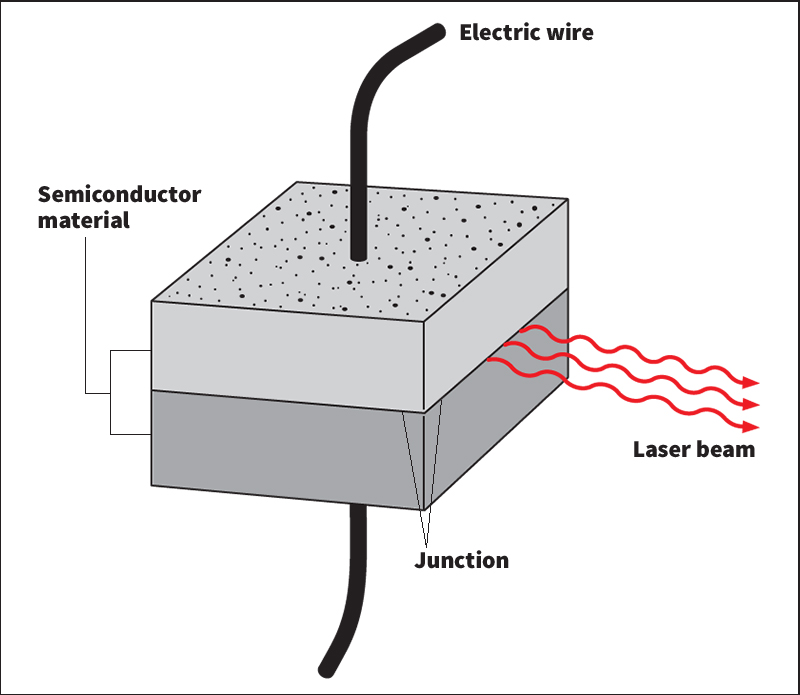
Liquid crystal displays
(LCD’s) are commonly used in calculators, digital watches, and laptop computers. A thin layer of a special chemical called a liquid crystal is sandwiched between two sheets of glass. A voltage signal causes portions of the display to darken or to change the color of light transmitted from a source behind the display. These portions form the shape of a number or letter, or part of an image. See Liquid crystal.
How electronic circuits process information
Circuits process information by combining inputs to produce new information according to instructions. The manner in which a circuit processes information depends on the type of signals it works with.
Electronic circuits work with two basic types of signals: (1) digital and (2) analog. Digital signals represent all information with a limited number of voltage ranges, typically two. Each voltage range has a distinct value. Analog signals vary continuously in voltage or current, corresponding to the input information. A fluctuating voltage can stand for changes in light, sound, temperature, pressure, or even the position of an object.
Digital circuits
process information by counting or comparing signals. Many digital circuits can process information much faster than analog circuits. The majority of processing is done by digital circuits.
In digital processing, all input data—words, numbers, and other information—are translated into binary numbers, which are groups of 1’s and 0’s. The code is called binary (consisting of two) because only two digits are used. Any binary number can be represented by a combination of circuits or devices that are in one of two states. For example, a circuit can be on or off. One state corresponds to a binary 1, and the other to a 0. Each 1 or 0 is called a bit, a contraction of bi_nary digi_t. Many systems work with bits in groups called words. A word that consists of 8 bits is called a byte.
Digital processing requires three basic elements: (1) memory circuits, which store data; (2) logic circuits, which change data; and (3) control circuits, which direct the operations of the system. Conductive channels called buses link the elements to each other as well as to the entire system. A microprocessor combines these elements on one chip.
Memory circuits
store bits permanently or temporarily. A common type of memory circuit contains millions of capacitors arranged in rows. The capacitors hold bits as an electric charge or the absence of a charge. A metal conductor connects each capacitor to the system. Transistors act as switches between the capacitors and conductors. When a signal opens a switch, bits can travel along the conductor. Other circuits then restore the bits by recharging the capacitors with the same sequence of charges.
There are two basic kinds of memory circuits—random-access memory (RAM) and read-only memory (ROM). The information in RAM can be erased or added to. Volatile RAM circuits store data only as long as the power is on. When the power is turned off, all the stored charges are wiped out. Nonvolatile RAM circuits can store data in the form of charges for long periods, even without power. RAM circuits are used in such devices as computers and certain calculators, which need to store large amounts of information for brief periods.
A ROM circuit permanently stores information installed at the time of manufacture. This information can be neither erased nor added to. ROM generally contains instructions, or programs, for operating the system.
Not all information is stored in circuits. For example, computers also use external storage devices, such as flash memory drives and CD-ROM’s. Other types of storage devices include compact disc drives, also called CD drives, which store data on CD’s, and DVD drives, which store information on DVD’s. DVD’s resemble CD’s, but they can store many times more information. CD’s and DVD’s can store data, pictures, and sound as well as programs.
Logic circuits,
also called processors, manipulate data according to instructions. In a processor, the bits go through a sequence of switches that change them in some way. For example, a group of switches may add two numbers together. Such a group is called an adder. An adder may involve hundreds of switches. During processing, bits are stored temporarily in areas called registers, awaiting the next instruction.
Another combination of switches can compare two bits and generate a particular output based on a set of rules established for the processor. Such circuits use binary digits to stand for such ideas as “true” or “false,” instead of 1 or 0.
Designers create areas on chips that can count or compare signals by combining small groups of circuits that make simple changes in just one or two bits. These groups are often called logic gates. Three basic gates are (1) the NOT-gate, (2) the AND-gate, and (3) the OR-gate. If combined in large enough numbers, these gates can solve complex mathematical or logical problems.
A NOT-gate, also called an inverter, changes a bit from a 1 to a 0, or from a 0 to a 1. Such a function has many uses. For example, addition involves changing 0’s to 1’s and 1’s to 0’s.
Both AND- and OR-gates generate one output signal from two or more inputs. An AND-gate requires that all inputs be true—often represented by a 1—to produce a true output, or a 1. An OR-gate requires only one true input to produce a true output.
Control circuits
direct and coordinate the work of all other parts of the system according to instructions stored in the memory circuits. One of the main jobs of the control circuit is to control the movement of bits through the system. To do this, an oscillator called the clock generates continuous pulses. The bits move through the circuit according to the rhythm of the clock.
Analog circuits
solve problems by measuring continuously varying quantities, such as temperature, speed, and pressure. A mechanical bathroom scale is a simple example of an analog computer. Small analog circuits are parts of many electronic systems that control the operations of other machines. Analog circuits are also used in some equipment for sound recording and reproduction. For more information on analog processing, see Analog computer.
Digital-analog conversion.
Some circuits can convert analog signals into digital signals, and digital into analog. In digital sound recording, for example, the amplitude (strength) of the sound wave is measured thousands of times every second and converted into a digital code signal made up of rapid bursts of current. To play the resulting digital signals, a sound system converts them back to analog signals that drive a loudspeaker. Digital signals can produce better sound quality with less background noise and distortion than analog signals can.
The electronics industry
The electronics industry is one of the largest and most important industries in the world. It involves the development, manufacture, and sales of electronic products.
Research and development.
Engineers and scientists at research laboratories work to add new knowledge about electronics and to develop new electronic devices. In many countries, most basic research in electronics and related fields takes place at universities and is funded by both industry and government. The United States government sponsors electronics research through such agencies as the National Science Foundation, the National Aeronautics and Space Administration, and the Department of Energy. The government also sponsors research through its military branches.
Manufacturing and sales.
China, the United States, and Japan are three of the world’s largest producers of electronic components and assembled electronic products. In the early 2020’s, about 10 million people in China worked for electronics companies. During this same period, electronics companies in the United States employed about 845,000 workers. The sales of these companies totaled about $360 billion. In the early 2020’s, electronics companies in Japan employed about 525,000 workers. The Japanese firms had total sales valued at about $100 billion, in U.S. dollars. Other leading producers of electronic equipment include Germany, Singapore, South Korea, Taiwan, and the United Kingdom.
Careers in electronics
can be divided into two main groups. These groups are (1) engineering and scientific careers and (2) technical careers.
Engineering and scientific careers
range from developing new electronic devices to designing computers. Most of these careers require a college degree in engineering or physics. The World Book articles on Engineering and Physics discuss the requirements for becoming an electrical engineer and a physicist.
Most engineers and physicists who specialize in electronics work for electronics companies. Some of these companies do most or all of their work on military projects. Other engineers and physicists find jobs with the federal government, at colleges and universities, and in communication, medicine, or transportation.
Technical careers
in electronics usually involve installing, operating, maintaining, or repairing electronic equipment. Many technical jobs require training in a trade school or community college. Such technical careers include automation control, computer networking and software maintenance, and medical technology.
Other technical jobs require only on-the-job training. Such jobs include operating certain types of electronic equipment in factories and offices. Some highly skilled technical jobs in the aerospace and communications industries require a college degree. Many people receive technical electronics training in the armed forces.
The development of electronics
Early experiments.
During the mid-1800’s, scientists experimented with gas-discharge tubes—that is, tubes from which some of the air had been removed. Most of these tubes contained a combination of such gases as oxygen and nitrogen at low pressure. Scientists discovered electric current could pass through the gas from one metal electrode (conductor) to another. When a battery was connected to the two electrodes, the space inside the tube glowed with bright colors. Scientists believed that one of the electrodes—called the cathode—gave off invisible rays that caused the colors. They named the rays cathode rays. As scientists removed still more air from the tubes for their experiments, the tubes became vacuum tubes.

In 1895, the German physicist Wilhelm C. Roentgen discovered X rays while studying cathode rays in a Crookes tube. By the early 1900’s, many doctors were using X-ray photographs to diagnose internal diseases and injuries in their patients.
In 1897, the British physicist Joseph J. Thomson proved that cathode rays consist of negatively charged particles, later named electrons. Thomson’s discovery led to the first practical electronic devices.
During the early 1900’s, electrical engineers developed vacuum tubes that could detect, amplify, and create radio signals. In 1906, the American inventor Lee De Forest created a three-electrode, or triode, vacuum tube. The triode tube became a key element in radio broadcasting and reception because it could amplify signals. Commercial radio broadcasting began in 1920, and the electronics industry was born. By 1927, more than 5 million homes in the United States had radios.
The vacuum tube era
lasted from the early 1900’s to the 1950’s. During this period, vacuum tubes made possible such electronic inventions as television, radar, and computers.
As early as 1875, the American scientist G. R. Carey had built a photoelectric cell, a device that produced an electric current when light shone on it. Carey’s invention operated on the same principle as a TV camera, but it was not put to practical use until the early 1920’s. In 1923, a Russian-born American engineer named Vladimir K. Zworykin made the first successful television camera tube. Using a cathode-ray tube as a model, Zworykin also developed a workable television picture tube during the 1920’s. Experimental telecasts began in the late 1920’s, but TV broadcasting did not begin on a large scale until the late 1940’s.
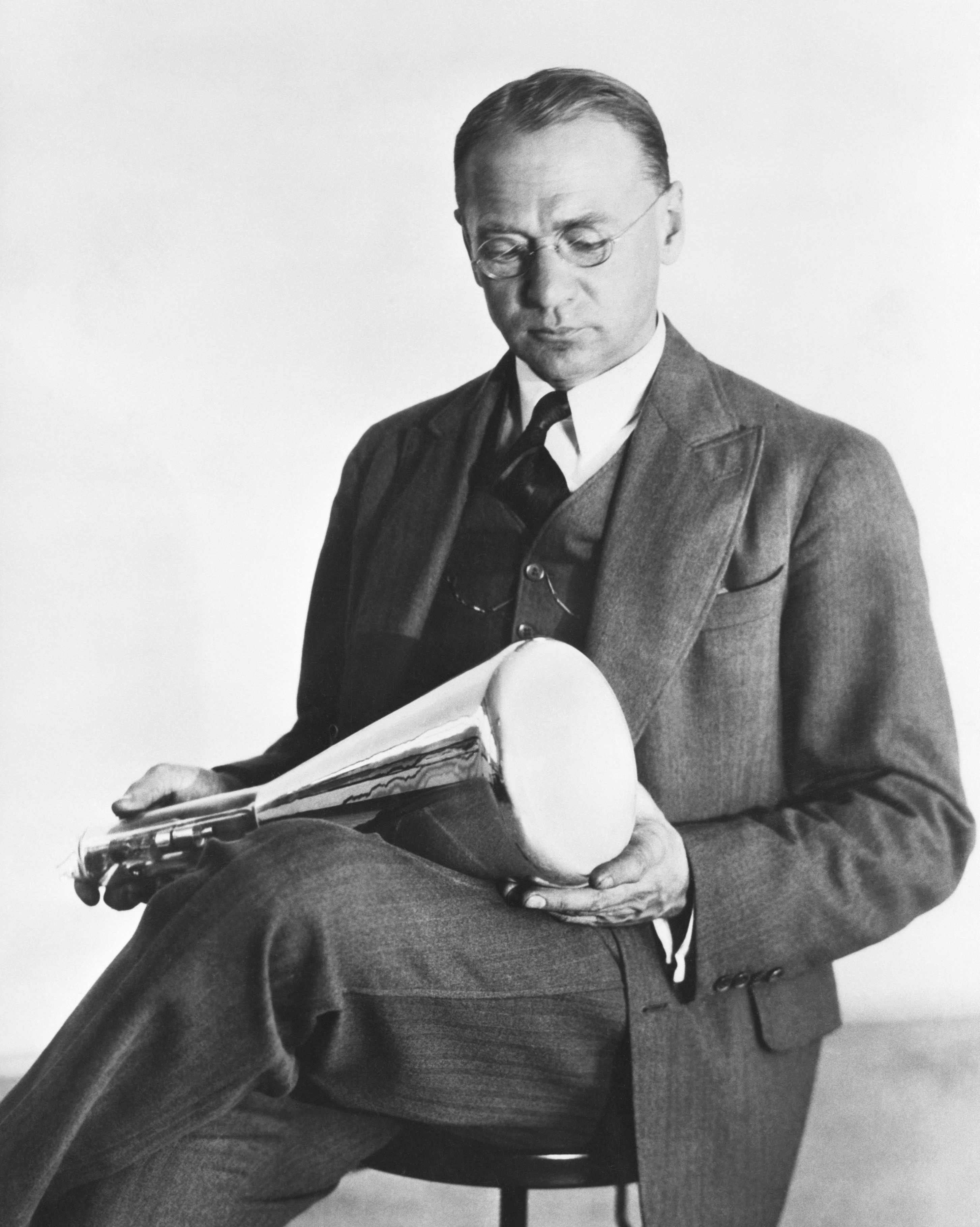
In 1921, Albert W. Hull, an American engineer, invented the vacuum tube called the magnetron. Other engineers later discovered that the magnetron could efficiently produce microwaves—the first device to do so. Radar, which was developed gradually during the 1920’s and 1930’s, provided the first widespread use of microwaves.
The vacuum tube era reached its peak with the completion of one of the first general-purpose electronic digital computers in 1945. This huge machine, called ENIAC (Electronic Numerical Integrator And Computer), was built by two engineers at the University of Pennsylvania, J. Presper Eckert, Jr., and John W. Mauchly. The computer contained about 17,500 vacuum tubes and occupied about 1,800 square feet (170 square meters) of floor space. ENIAC worked 1,000 times faster than the fastest nonelectronic computers then in use.
The solid-state revolution.
Three American physicists—John Bardeen, Walter H. Brattain, and William Shockley—invented the transistor in 1947. Transistors revolutionized the electronics industry, dramatically reducing the size of computers and other equipment. Transistors were used as amplifiers in hearing aids and pocket-sized radios in the early 1950’s. By the 1960’s, semiconductor diodes and transistors had replaced vacuum tubes in many types of equipment.
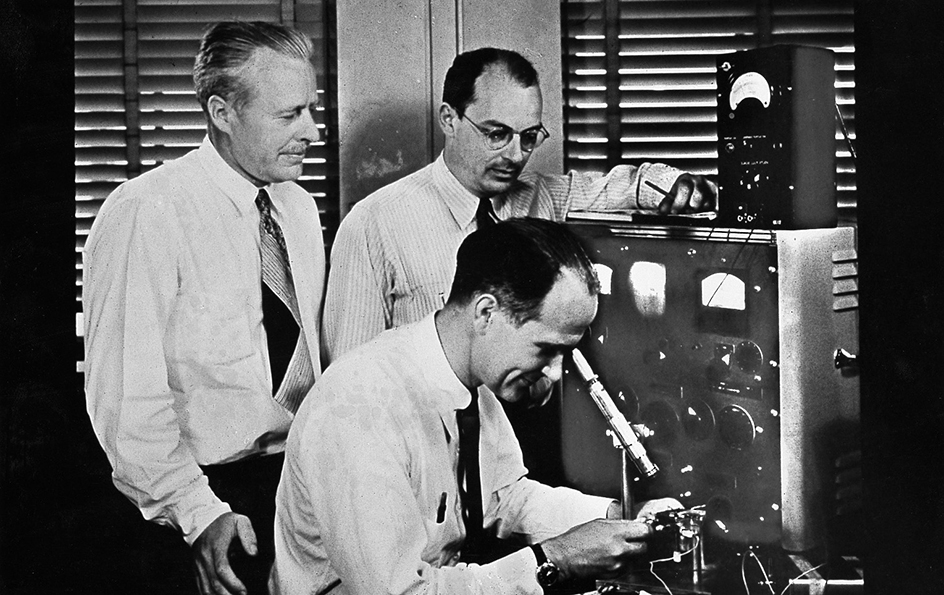
Integrated circuits developed from transistor technology as scientists sought ways to build more transistors into a circuit. The first integrated circuits were patented in 1959 by two Americans—Jack Kilby, an engineer, and Robert Noyce, a physicist—who worked independently. Integrated circuits caused as great a revolution in electronics in the 1960’s as transistors had caused in the 1950’s.
The first microprocessors were produced in 1971 for desktop calculators. By the mid-1970’s, microprocessors were being used in handheld calculators, video games, and home appliances. Business and industry began to use microprocessors to control various types of office machines, factory equipment, and other devices.
The digital age.
In the 1980’s and 1990’s, many products began to take advantage of digital technology. Personal computers became commonplace in the home. Digitally recorded music became available on compact discs. Manufacturers introduced the DVD, which can hold a complete video recording of a motion picture on a single disc, with significantly better picture quality than magnetic videotape.
In the 1990’s, communication systems that use digital technology gained in importance. The Internet grew from a few thousand users in 1990 to many millions by the early 2000’s. A digital technique called data compression was applied to television to remove unnecessary information from the signal. One type of digital television—high-definition television (HDTV)—provides a picture about four times as sharp as standard analog television does. HDTV broadcasts began in Japan in 1996 and in the United States in 1998.
Electronics today.
Scientists and engineers continue to search for ways to make electronic circuits smaller, faster, and more complex. Developing technologies include photonics and quantum computing.

Photonics is the science of building circuits that use photons as signals instead of electrons. Photonic circuits use pulsed beams of photons to transmit data and commands through optical fibers. Photonic circuits can carry huge amounts of information, and they produce virtually no heat. Today, the huge information-carrying capacity of optical fibers is opening a new era in home entertainment, communications, and computer technology.
Scientists and engineers seek to develop quantum computers, which use the quantum-mechanical properties of photons and other particles to perform certain tasks. One such task involves making calculations related to cryptography (using and deciphering secret communications). Quantum computers have the potential to solve some mathematical problems millions of times faster than conventional computers.

Display techniques in electronics are also rapidly changing. Manufacturers have developed flatter display panels to replace the bulky cathode-ray tubes used in television screens and many computer screens. These displays include liquid crystal displays and plasma displays. A plasma display uses a layer of gas between two glass panels. An electric current passed through the gas ionizes it, producing ultraviolet light that excites red, blue, and green chemicals called phosphors on the surface of the glass. A display method called digital light processing uses a microelectromechanical system consisting of as many as two million tiny mirrors on a special type of integrated circuit. A powerful beam of light is directed at the mirrors, which move to reflect light onto a rear-projection display screen, producing full-color images. See Microelectromechanical systems (MEMS). In the 2010’s, LED’s became relatively affordable and began widely replacing such older light sources as incandescent and fluorescent bulbs.
